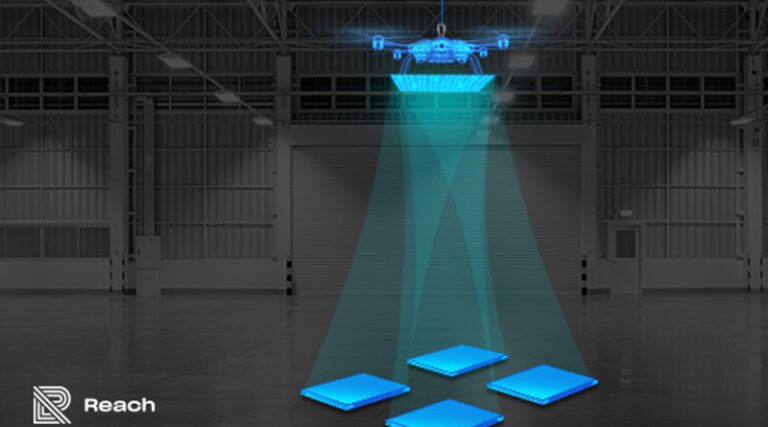Sign up for daily news updates from CleanTechnica on email. Or follow us on Google News!
REDWOOD CITY, California — Under a BAA (Broad Agency Announcement) funded project with Defense Advanced Research Projects Agency (DARPA), Reach, the Wireless Power-at-a-Distance company developed and demonstrated a groundbreaking radio frequency (RF) based wireless power transfer (WPT) system for Unmanned Aerial Vehicles (UAVs). The demonstration, which took place at National Aeronautics and Space Administration’s (NASA) Ames Research Center, showcased Reach’s Wireless Power-at-a-Distance solution by beaming 256 watts of power at a drone in flight. The demo used four Reach Wireless Power Transmitters collaborating to create a mesh network. This transmitter network sent power to a Reach Wireless Power Receiver integrated with a 5 lbs. quadcopter drone.

“This successful demonstration is a critical step towards creating a practical, scalable RF-based wireless power network,” said Reach Founder and Chief Executive Officer Chris Davlantes. “Energy is fundamental to every aspect of our lives. We believe that more flexible and resilient power distribution networks enabled by wireless power transfer will revolutionize a vast array of military and commercial applications in the near future.”
The Reach system sent power to the in-flight drone by beaming wireless electricity at a distance of approximately 6 meters. The primary objective of the project was to demonstrate that multiple wireless power transmitters could work in unison forming a mesh network to wirelessly power a device.
Building a Wireless Power Mesh Network
A wireless power mesh network is a collection of interconnected devices — collocated or dispersed — functioning as a unified network. The wireless power mesh provides numerous sources of power, delivering more power and a wider coverage area. Widespread adoption of mesh networking for Wi-Fi has opened the door to similar architectures for wireless power as it has driven innovation, cost reduction, and availability.
Like conventional Wi-Fi mesh networks, Reach’s wireless power mesh network delivers uninterrupted service to devices within its coverage area but provides wireless power access versus Wi-Fi connectivity. This innovative network of wireless power holds immense potential across various domains, including energizing robots in manufacturing plants, charging tools at construction sites, and establishing temporary power grids for efficient disaster response efforts.
Wireless power mesh networks have several key advantages:
- They facilitate higher power levels and extended distances between the transmitter and receiver.
- They employ intelligent algorithms to optimize power delivery based on demand.
- They deliver resilience by incorporating redundant backup technology and ensuring continued power supply in the event of physical interference with or failure of a transmitter.
- They are flexible and highly scalable with modular mesh components that are easy to add or remove as needed.
During this demonstration Reach achieved three ground-breaking milestones:
- Transmitting constant power in the 100s of watts at a wireless power receiver at-a-distance.
- Demonstrating the capability to mesh multiple transmitters — power beams — to increase overall power at the receiving end.
- Demonstrating a resilient power beaming network with no single point of failure that can deliver uninterrupted power even if transmitters are removed.
By meshing four transmitters together, the system delivered 50 Watts to the drone to charge its battery. The team also demonstrated fault tolerant networking that enabled the graceful failover of individual power sources. Even as the power reduced, the remaining power sources were still able to deliver power to the drone.
The successful demonstration by Reach represents a significant step forward in the use of wireless power technology to keep UAVs, robots, and other electronic devices powered and charging while operational. This technology revolutionizes operations for government, military, and commercial customers, providing them with a safe, efficient, and dependable source of persistent power to optimize their activities and extend their missions.
Press release from Reach.
Reach is the Wireless Power-at-a-Distance company. Reach’s wireless power changes electric power delivery in the same way that Wi-Fi changed data delivery. The system is built on state-of-the-art, patented technology, including high-efficiency power beaming circuits, network optimization algorithms, and adaptive electromagnetic surfaces, delivering a highly scalable, safe, and easy-to-use power platform. Ideally suited for manufacturing, government, energy, logistics, and retail, the Reach solution provides flexible access to power where and when needed, streamlining device deployment, and improving device performance.
Have a tip for CleanTechnica? Want to advertise? Want to suggest a guest for our CleanTech Talk podcast? Contact us here.
Latest CleanTechnica.TV Videos
CleanTechnica uses affiliate links. See our policy here.


